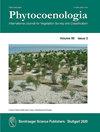Classification of aquatic vegetation (Potametea) in Baikal Siberia, Russia, and its diversity in a northern Eurasian context
IF 0.9
4区 生物学
Q4 ECOLOGY
引用次数: 17
Abstract
We studied the aquatic vegetation of bottom-rooted plants, i.e. the class Potametea, in Baikal Siberia, a region in the south of Eastern Siberia. Forty associations were found based on 623 original relevés and 65 relevés from the literature. Six associations (Lemno trisulcae-Sparganietum graminei , Myriophyllo spicati-Potametum compressi , Potametum bottnici , Potametum maackiani, Potametum salicifoli i , Potametum vaginati) are described here for the fi rst time. The names of fi ve syntaxa have been typifi ed. Nine new community-types were recorded for Baikal Siberia. Each association is outlined by its diagnostic, constant and dominant species, structure, ecology and distribution. The regional distribution of each association is shown by grid maps. Large-scale phytogeographical comparison of sets of diagnostic species of Potametea across Northern Eurasia revealed that Baikal Siberia harbours two thirds of the diversity of macrophyte vegetation of Northern Asia and 40% of that of Northern Eurasia. Our study showed that Baikal Siberia’s Euro-Siberian aquatic vegetation gradually declines in species and community richness towards east. The aquatic vegetation was found to be rich in thermophilous plants in the Russian Far East along the lower course of the Amur River.俄罗斯贝加尔湖西伯利亚水生植被(Potametea)的分类及其欧亚北部背景下的多样性
本文研究了东西伯利亚南部贝加尔湖西伯利亚地区的底根植物(Potametea纲)水生植被。根据623个原始的相关数据和文献中的65个相关数据,发现了40个关联。本文首次报道了6个植物群(Lemno trisulcae-Sparganietum graminei, Myriophyllo spicati-Potametum compressi, Potametum bottnici, Potametum maackiani, Potametum salicifoli i, Potametum vaginati)。在贝加尔湖西伯利亚地区记录到9个新的群落类型。每一种群落由其诊断种、常种和优势种、结构、生态和分布进行概述。每个关联的区域分布由网格图显示。通过对欧亚大陆北部的大尺度植物地理比较,发现西伯利亚贝加尔湖拥有北亚三分之二和欧亚大陆北部40%的大型植物植被多样性。研究表明,西伯利亚贝加尔湖欧洲-西伯利亚水生植被的种类和群落丰富度向东递减。在俄罗斯远东沿阿穆尔河下游的水生植被中发现了丰富的嗜热植物。
本文章由计算机程序翻译,如有差异,请以英文原文为准。
求助全文
约1分钟内获得全文
求助全文
来源期刊

Phytocoenologia
生物-植物科学
CiteScore
2.60
自引率
0.00%
发文量
7
审稿时长
>12 weeks
期刊介绍:
Phytocoenologia is an international, peer-reviewed journal of plant community ecology. It is devoted to vegetation survey and classification at any organizational and spatial scale and without restriction to certain methodological approaches. The journal publishes original papers that develop new vegetation typologies as well as applied studies that use such typologies, for example, in vegetation mapping, ecosystem modelling, nature conservation, land use management or monitoring. Particularly encouraged are methodological studies that design and compare tools for vegetation classification and mapping, such as algorithms, databases and nomenclatural principles. Papers dealing with conceptual and theoretical bases of vegetation survey and classification are also welcome. While large-scale studies are preferred, regional studies will be considered when filling important knowledge gaps or presenting new methods.
 求助内容:
求助内容: 应助结果提醒方式:
应助结果提醒方式:


